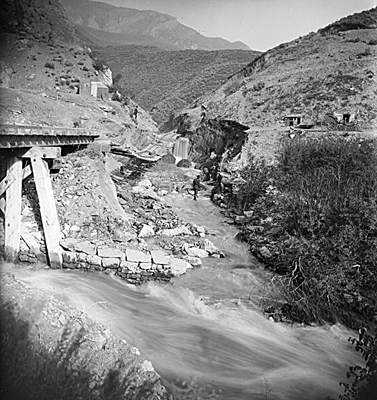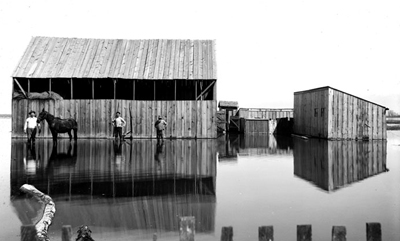Utah is largely a desert state, but that doesn’t mean floods can’t happen. Too much water can be as damaging as too little water. This is especially true when sheep and cows have overgrazed the mountains, leaving few plants to capture runoff water.
The Big Flood of 1923

Overgrazing in the mountains caused a huge flood when a heavy rainstorm hit the northern Wasatch Mountains on August 13, 1923. Above Willard, the water ran down the hills into the canyon, then burst into the town at about 8 p.m.
V. M. Graser went outside to check on a loud rumbling noise and in a flash of lightning saw a wall of water rushing into his house. His family barely escaped. Another family climbed a tree to escape.
Sadly, in Farmington Canyon, four Boy Scouts and a honeymooning couple were killed.
The flood destroyed houses and barns and filled others with up to 13 feet of mud; covered the Willard highway with mud, boulders, and trees; buried cars in mud; and destroyed crops and even destroyed the agricultural land itself.
The Sanpete County Flood of 1946
On Pioneer Day, July 24, 1946, a huge rainstorm caused floods that covered Mount Pleasant’s main street with four feet of water and carried cars downstream. People had to use boats to get around. The water, rocks, and debris severely damaged several buildings and killed livestock.

The Morgan County Flood of 1958
On August 16, 1958, a thunderstorm dropped 6.75 inches of rain in Morgan County, causing a flash flood. The local newspaper wrote:
Flash floods streaked down canyons from North Morgan to Round Valley about 4 P.M. Saturday causing several thousand dollars damage to property and closing Highway 30-S for several hours with mud, rock, and water.
Hardest hit was the Joseph E. T. Rees place in Round Valley, where a cattle shed was severely damaged . . . 60 acres of hay was completely ruined and 10 acres of pasture covered with mud and rocks.
Eighteen pure bred bulls and 12 steers in corrals and sheds . . . narrowly escaped death. The bulls were washed end over end from a shed against a corral fence where only quick action by Mr. Rees in cutting them free of the corral saved several of them from drowning.

Paul Rees was pinned against the corral fence by the force of the water and had to be rescued by his father.
Floods in Washington County
With little vegetation on the hills to begin with, Washington County saw lots of flash floods. Lizzie Ballard Isom described the floods she saw as a young girl growing up in Grafton:
We witnessed many awful floods in the [Virgin] river. One I so well remember was so thick with dirt and logs that it moved so slowly that a person could have run across in front of it. Timber and dirt together made it look like the side of a log house. Father took a can and dipped some of what was supposed to be water and poured it on a log and it was so thick that it hardly reached the ground.
All floods were not the same. One day another flood came and was running so swift with everything imaginable in it. There was a cow that had been caught in its path along with bee hives, all kinds of farm equipment, field and garden produce. Men tried to catch the cow by the horns with a lasso but the swift water filled with trees prevented her from getting near enough so they could get the rope on her and she went down. The floods came so many times and claimed so much of the land that the people became discouraged and abandoned Grafton.
The 1861-62 flood
It began raining Christmas Day 1861 in Washington County. It rained every day for 40 days. Floods washed away the fort in Santa Clara. The adobe Fort Harmony caved in, killing two children.

In Grafton, as the river rose on January 8, Mrs. Nathan Tenney was about to give birth inside the wagon box where the family was living. Nathan’s neighbors helped him carry the box to higher ground so the river wouldn’t sweep it away. The new baby boy got a name that made sure he remembered how he was born: his parents named him Marvelous Flood Tenney.
More recently
In 1983, soil saturated with water and melting snows caused a huge landslide on a hill in Spanish Fork Canyon. Thistle Creek backed up behind the slide and created a lake that covered the town of Thistle.
In Salt Lake County, a lot of snow melted very quickly around Memorial Day, turning the creeks into raging rivers. For a few weeks, the overflowing waters turned 13th South and State Street into rivers.
In 2005, the Virgin River flooded so ferociously that it carried off huge chunks of its banks (along with cars, trees, shrubs, and much more). The flood destroyed 25 homes sitting on the riverbank and damaged another 200.
Keep Exploring!